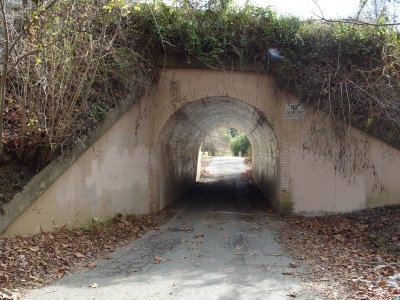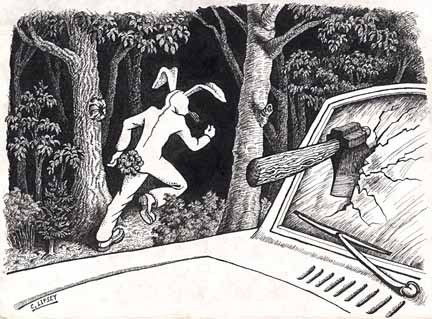| |
Unexplained Mysteries - Urban Legend of Bunnyman Bridge |
|
Source : http://en.wikipedia.org/wiki/Bunny_Man
 |
|
The Bunny Man is an urban legend that probably originated from two incidents in Fairfax County, Virginia in 1970, but has been spread throughout the Washington D.C. area. There are many variations to the legend, but most involve a man wearing a rabbit costume ("bunny suit") who attacks people with an axe. Many variations occur around "Bunny Man Bridge", the concrete tunnel of a Southern Railway overpass on Colchester Road in Clifton. Story variations include the origin of the Bunny Man, names, motives, weapons, victims, description of the bunny suit, and the possible death of the Bunny Man. In some accounts the Bunny Man's ghost or aging spectre is said to come out of his place of death each year on Halloween to commemorate his death. In some accounts, victims' bodies are mutilated.
You sit in your car, your date by your side, wondering just what you're doing here. This place is bad; everyone says so. You've heard the tales of death and spectral madmen that leap from the bushes and separate people's heads from their necks. Yet, you are here, hoping that the crickets that chirp like nervous heartbeats and echoes that sound like whispers will bring her closer to you. And you don't believe the stories anyway, right? They're just made up to scare kids away from here. But then, why is your heart racing in time with hers? Why do the echoes sound more like whispers? And why do the shadows move like inky wraiths across the walls toward your car? Surely it couldn't be real. None of it could be true. Could it?
Tales of terror, believed almost without question, are passed around from friend to friend to friend of a friend, all with the insistence that they are true. Everyone seems to know someone who has a cousin whose boyfriend's sister knows where any given event really happened. We call such stories urban legends, and more often than not, they're not true. But once in a while, the truth rears its head, and that is often the most bizarre part of the story. It becomes something of a widespread practical joke. The Bunnyman Bridge.
The Legend:
Sometime around 1905 near the Fairfax County town of Clifton, Virginia, there was a mental institution that housed the severely disturbed and criminally insane. The citizens of the county wanted no part in such a facility being so close to their homes and protested, prompting the facility to shut down and transfer the inmates to another facility in another county. The bus containing all the inmates, however, never made it to its destination. It was struck by a train, killing several of the inmates and freeing others. It took the wardens and police a few days, but in the end they managed to round up all but two.
In the weeks that followed it became obvious that the two escapees were still hanging around the vicinity as dozens, and soon hundreds, of carcasses of half-eaten rabbits were found strewn about the bridge and the surrounding areas. Another search was ordered, this one widening the search area into the woods. There, hanging in a tree, officers found Marcus Walster, one of the two escapees. He'd been gutted and dressed like a deer in much the same way the rabbits had been. It was then that they began referring to the second escapee, Douglas J. Grifon, as the "Bunnyman."
When they finally found Grifon, he was in a feral state, clawing and biting at the guards, covered in the blood of both rabbits and Walster. As they moved in to apprehend him, he climbed the embankment to the train tracks and leaped in front of an oncoming train. It seemed to be the end of the Bunnyman.
From the time of his death Grifon was sighted on or near the bridge, sometimes hiding inside the tunnel beneath. Whatever his motive, his intention was clear. He was still looking for victims. Between the years of 1905 and 1980, there were dozens of unexplained deaths at the bridge, all with a chilling modus operandi. Disobedient children and vagrants, mostly, have met with a terrible demise, found later gutted and strung up around the entrance to the bridge. Often the victims were amorous teen-agers who were going off for some alone time.
In the late 1980's tragedy struck again as a group of four teens went to The Bunnyman Bridge, trying to scare their dates into more intimate encounters. Two split off from the group and traveled farther down the tracks for some privacy, and when they didn't return for quite some time, the other two decided they'd found a good spot and were enjoying themselves. They left, deciding it would be funny to make their friends walk home. The next day their friends' lifeless corpses hung, gutted, from the trees around The Bunnyman Bridge. Around their feet lay the tattered remains of several rabbits.
The legend takes a strange turn as the Bunnyman made more appearances. During this phase of the legend, he appeared in the middle of the night, dressed in a large bunny costume, and threw hatchets at passing cars before shouting at them and disappearing into the woods. Rumor made this "Bunnyman" out to be a crazed man who murdered his own children on Easter Sunday with an axe.
Over the past twenty years The Bunnyman Bridge has become a hot spot for teens looking for a thrill and amateur ghost hunters alike, and the death toll continues to rise. The bridge is such a trouble spot that local police have installed security cameras in hopes of warding off anyone foolhardy enough to hang around the place at night.
Origin
Fairfax County Public Library Historian-Archivist Brian A. Conley has conducted extensive research on the Bunny Man legend. He has located two incidents of a man in a rabbit costume threatening people with an axe. The vandalism reports occurred a week apart in 1970 in Burke, Virginia.
The first incident was reported the evening of October 20, 1970 by USAFA Cadet Bob Bennett and his fiancée, Dusty, who were visiting relatives on Guinea Road in Burke. Around midnight, while returning from a football game, they parked their car in a field on Guinea Road to talk. As they sat in the front seat with the car running, they noticed something moving outside the rear window. Moments later the front passenger window was smashed and there was a white-clad figure standing near the broken window. Bennett turned the car around while the man screamed at them about trespassing, including "You're on private property and I have your tag number." As they drove down the road they discovered a hatchet on the car floor.

When the police asked for a description of the man, Bob insisted he was wearing a white suit with long bunny ears, but Dusty remembered something white and pointed like a Ku Klux Klan hood. They both remembered seeing his face clearly, but in the darkness they could not determine his race. The police returned the hatchet to Bennett after examination. Bennett was required to report the incident upon his return to the USAFA. It was later confirmed in Fairfax Police records that the man was wearing a bunny suit with ears instead, not Ku Klux Klan robes.
The second reported sighting occurred on the evening of October 29, 1970, when construction security guard Paul Phillips approached a man standing on the porch of an unfinished home in Kings Park West on Guinea Road. Phillips said the man was wearing a gray, black, and white bunny suit and was about 20 years old, 5 feet 8 inches (1.73 m) tall, and weighed about 175 pounds (79 kg). The man began chopping at a porch post with a long-handled axe, saying "All you people trespass around here. If you don't get out of here, I'm going to bust you on the head." The man then ran into the woods.
The Fairfax County Police opened investigations into both incidents, but both were eventually closed for lack of evidence. In the weeks following the incidents, more than 50 people contacted the police claiming to have seen the "bunny man." Several newspapers reported the incidents, including the following articles in The Washington Post:
* "Man in Bunny Suit Sought in Fairfax" (October 22, 1970
* "The 'Rabbit' Reappears" (October 31, 1970)
* "Bunny Man Seen" (November 4, 1970)
* "Bunny Reports Are Multiplying" (November 6, 1970)
In 1973, University of Maryland student Patricia Johnson submitted a research paper that chronicled precisely 54 variations on those two events.
The legend
The legend has circulated for years in several forms. A version naming a suspect and specific location was posted to a web site in the late 1990s by a "Timothy C. Forbes". This version states that in 1904, an asylum prison in Clifton, Virginia was shut down by successful petition of the growing population of residents in Fairfax County. During the transfer of inmates to a new facility, the transport carrying the inmates crashes; some prisoners escaped or were found dead. A search party finds all but one of them.
During this time, locals allegedly began to find hundreds of cleanly skinned, half-eaten carcasses of rabbits hanging from the trees in the surrounding areas. Another search of the area was ordered and the police located the remains of Marcus Wallster, left in a similar fashion to the rabbit carcasses hanging in a nearby tree or under a bridge overpass—known locally as the "Bunny Man Bridge"—along the railroad tracks at Colchester Road. Officials name the last missing inmate, Douglas J. Grifon, as their suspect and call him "the bunny man".
In this version, officials finally manage to locate Grifon but, during their attempt to apprehend him at the overpass, he nearly escapes before being hit by an oncoming train where the original transport crashed. They say after the train passed the police said that they heard laughter coming from the site. It is eventually revealed that Grifon was institutionalized for killing his family and children on Easter Sunday.
For years after the "Bunny Man's" death, in the time approaching Halloween carcasses are said to be found hanging from the overpass and surrounding areas. A figure is reportedly seen by passersby making their way through the one lane bridge tunnel.
Conley says this version is demonstrably false. Among other inconsistencies, Conley notes that "there has never been an asylum for the insane in Fairfax County" and that "Lorton Prison didn't come into existence until 1910, and even then it was an arm of the District of Columbia Corrections system, not Virginia's." Court records show neither a Grifon nor a Wallster and, writes Conley, "there is not and never has been a Clifton Town Library."
Cryptozoologist Loren Coleman, via his blog Cryptomundo and in the book Weird Virginia, which has a section on the Bunny man, sees a direct association between the legend of Bunny man and that of the Goatman of nearby Maryland.

Submit News/Videos/Links |
Discuss article |
Article Link
|
More unsolved mysteries on Unexplained Mysteries
|


![]()